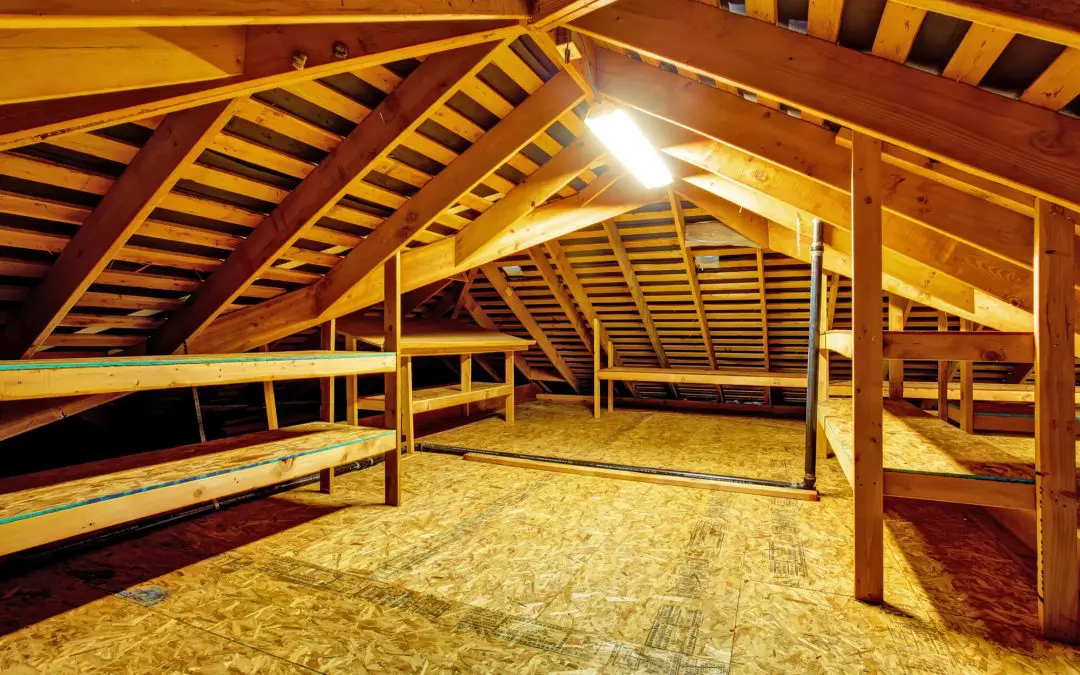Attic storage only works if you can get in and out safely and actually find what you need. For a lot of homeowners, the attic ends up as a dumping ground—awkward to reach, poorly lit, and full of hazards. It doesn’t have to be that way. With a few smart upgrades, you can turn it into a reliable space that adds real value.
Check the Structure Before Building Attic Storage
Start with the basics. Not every attic was built to hold weight. A few exposed joists aren’t enough to support stacks of bins or someone walking around with boxes. Before adding anything, look at the size and spacing of the joists. Light framing means limited load capacity. Loading it up without reinforcement could lead to sagging ceilings or costly damage.
If you’re not sure what your attic can handle, bring in a professional. A qualified home inspector or contractor can confirm if the space is safe, or what needs to be reinforced before it’s used for storage.
Install Solid, Supported Flooring
Trying to balance on joists while hauling storage bins is a recipe for injury—or a foot through the ceiling. If the attic can handle the weight, install a layer of plywood or OSB to create walkable paths and stable storage zones. Nail everything down tight. Avoid laying boards over loose insulation without support underneath.
Don’t block attic ventilation. If there are soffit vents or baffles, make sure your flooring and boxes don’t smother the airflow. Blocked ventilation leads to heat and moisture buildup, which shortens the life of your roof and damages your stored items.
Upgrade the Access Point
A weak attic ladder is one of the biggest risks. Many of the original pull-down ladders that come with homes aren’t designed for regular use or heavy loads. If it feels wobbly or bends under your weight, replace it. Choose one rated for at least 250 pounds, and make sure it fits your opening properly and anchors securely.
For attics without built-in access, consider adding a fold-down ladder or scissor-style staircase with enough clearance to carry bins safely. Don’t rely on step stools or makeshift ladders.
Add Lighting You Can Count On
No one likes digging through boxes in the dark. Poor lighting makes everything harder—and more dangerous. At a minimum, install a central overhead light with a switch near the entrance. If the attic is large or divided into sections, add more lighting across the space. LED strips or battery-powered lights work in a pinch, but hardwired fixtures give the best coverage and reliability.
Once lighting is in place, it’s easier to organize, label, and find what you’ve stored.
Keep Temperature and Moisture in Check
Attics heat up fast in summer and drop below freezing in winter. That makes them risky for anything sensitive. Paper, photos, electronics, candles, and certain plastics will all suffer in extreme temperatures. Humidity adds another layer of risk, especially if there’s poor ventilation or past signs of roof leaks.
Before trusting your attic with anything valuable, improve airflow and seal out moisture. Make sure vents are clear, check for insulation gaps, and repair any roof damage that could let water in. A well-ventilated attic protects both your home and your stored items.
Store with a Plan
Storage works best when it’s organized. Stack bins by category and use the space intentionally. Keep the center walkway open, and don’t overload the floor—even if it’s been reinforced. Lighter, less-used items can go in the far corners. Frequently accessed items should be closer to the entrance.
Use sturdy plastic bins with lids. Avoid cardboard, which attracts pests and absorbs moisture. Label everything clearly so you don’t have to dig every time you go up.
Prioritize Safety in Attic Storage Every Time
Attics aren’t designed like closets. The layout is awkward, the temperature fluctuates, and the footing can be rough. Don’t carry heavy items alone. Always use both hands on the ladder. Wear solid shoes. Keep your trips up and down short and intentional. If anything feels sketchy or unstable, don’t risk it.
A well-prepped attic is useful. A neglected one is just a hazard.
Attic Storage FAQs
Is it safe to use my attic for storage?
Only if the structure can support it. Joists need to be sized and spaced properly, and flooring must be installed to avoid falls or damage.
What’s the best flooring for attic storage?
Plywood or OSB, fastened directly to the joists. Avoid laying boards loosely over insulation, which creates weak spots and safety risks.
Can I install an attic ladder myself?
If you’re comfortable with basic carpentry and the opening is already framed, yes. For first-time installs or uncertain framing, hire a pro.
What should I not store in the attic?
Photos, electronics, paperwork, candles, and anything that reacts badly to heat or moisture. These items are better off in climate-controlled areas.
How do I protect items stored in the attic?
Use sealed plastic bins, label everything, avoid overloading the space, and keep ventilation clear to prevent heat and humidity damage.
Delta Home Inspection provides home inspections in Mobile and Baldwin Counties in Alabama. Contact us to schedule our services.
